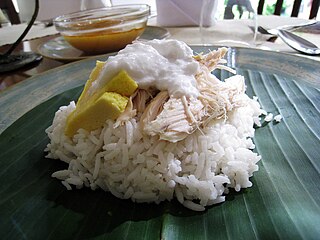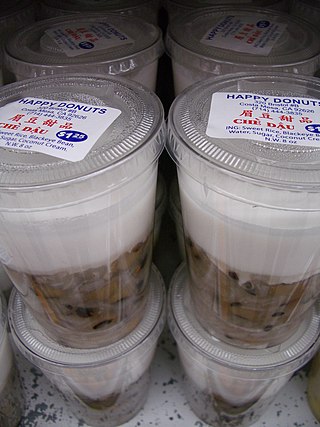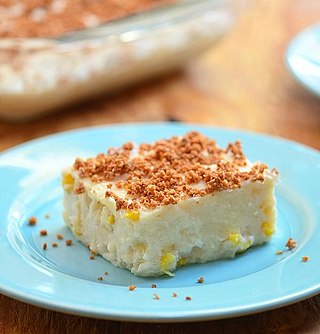
Thai cuisine is the national cuisine of Thailand.

Glutinous rice is a type of rice grown mainly in Southeast and East Asia, and the northeastern regions of South Asia, which has opaque grains, very low amylose content, and is especially sticky when cooked. It is widely consumed across Asia.
Malaysian cuisine consists of cooking traditions and practices found in Malaysia, and reflects the multi-ethnic makeup of its population. The vast majority of Malaysia's population can roughly be divided among three major ethnic groups: Malays, Chinese and Indians. The remainder consists of the indigenous peoples of Sabah and Sarawak in East Malaysia, the Orang Asli of Peninsular Malaysia, the Peranakan and Eurasian creole communities, as well as a significant number of foreign workers and expatriates.

Malay cuisine is the traditional food of the ethnic Malays of Southeast Asia, residing in modern-day Malaysia, Indonesia, Singapore, Brunei, Southern Thailand and the Philippines as well as Cocos Islands, Christmas Island, Sri Lanka and South Africa.

Kuih are bite-sized snack or dessert foods commonly found in Southeast Asia and China. It is a fairly broad term which may include items that would be called cakes, cookies, dumplings, pudding, biscuits, or pastries in English and are usually made from rice or glutinous rice. In China, where the term originates from, kueh or koé in the Min Nan languages refers to snacks which are typically made from rice but can occasionally be made from other grains such as wheat. The term kuih is widely used in Malaysia, Brunei, and Singapore, kueh is used in Singapore and Indonesia, kue is used in Indonesia only, all three refer to sweet or savoury desserts.

Kue is an Indonesian bite-sized snack or dessert food. Kue is a fairly broad term in Indonesian to describe a wide variety of snacks including cakes, cookies, fritters, pies, scones, and patisserie. Kue are made from a variety of ingredients in various forms; some are steamed, fried or baked. Kue are popular snacks in Indonesia, which has the largest variety of kue. Because of the countries' historical colonial ties, Koeé (kue) is also popular in the Netherlands.

Coconut rice is a dish prepared by soaking white rice in coconut milk or cooking it with coconut flakes. As both the coconut and the rice-plant are commonly found in the tropics all-around the world, coconut rice too is found in many cultures throughout the world, spanning across the equator from the Indian subcontinent, Southeast Asia, South America, Central America, East Africa, the Caribbean and Oceania.

Chè is any traditional Vietnamese sweet beverage, dessert soup or stew, or pudding. Chè includes a wide variety of distinct soups or puddings. Varieties of Chè can be made with mung beans, black-eyed peas, kidney beans, tapioca, jelly, fruit, and coconut cream. Other types are made with ingredients such as salt, aloe vera, seaweed, lotus seed, sesame seed, sugar palm seeds, taro, cassava and pandan leaf extract. Some varieties, such as chè trôi nước, may also include dumplings. Chè are often prepared with one of a number of varieties of beans, tubers, and/or glutinous rice, cooked in water and sweetened with sugar. In southern Vietnam, chè are often garnished with coconut creme.

Serabi (ꦱꦼꦫꦧꦶ), surabi (ᮞᮥᮛᮘᮤ), or srabi (ᬲ᭄ᬭᬩᬶ) is a traditional Balinese–Javanese snack, similar to a pancake, made of a rice flour-based batter with coconut milk or coconut cream and shredded coconut as an emulsifier. Most traditional serabi tastes sweet, as these pancake-like desserts are usually eaten with kinca (ᮊᮤᮑ᮪ᮎ), a golden-brown coconut sugar syrup in the Sundanese culinary tradition.

Maja blanca is a Filipino dessert with a gelatin-like consistency made primarily from coconut milk. Also known as coconut pudding, it is usually served during fiestas and during the holidays, especially Christmas.

Kue putu or putu bambu is an Indonesian kue. It is made of rice flour called suji and coloured green with pandan leaves, filled with palm sugar, steamed in bamboo tubes, and served with desiccated coconut. This traditional bite-sized snack is commonly found in maritime Southeast Asia, particularly in Java, Indonesia, where it is called putu bumbung. Kue putu is usually sold by street vendors and can be found in traditional markets, along with other kues. Kue putu can also be found in the Netherlands due to its colonial ties with Indonesia.
The nine auspicious Thai desserts are used for traditional ceremonies such as weddings or housewarmings, because of their good meaning.

Bua loi or bua loy is a Thai dessert. It consists of rice flour rolled into small balls, and cooked in coconut milk and sugar. Some Bua loi also adds sweet egg into the recipe. It was inspired by Tangyuan, a Chinese dessert that is traditionally eaten around the Lantern festival. Bua Loi also traditionally eats at the Dongzhi Festival in Thailand, which is festival for the Chinese-Thai bloodline. There are a variety of versions of Bua loi such as using food coloring instead of natural color, using soy milk instead of Coconut cream, sliced Pumpkin to add inside rice balls, et cetera. There's other type of Bua loi in other country from China, Japan, Indonesia, Myanmar, Philippines, and Southern Vietnam. 1 cup of Bua Loy has total calories of 295.5 kilocalories, protein of 10.4 grams, carbohydrate of 6.3 grams, and fat of 25 grams.
Khanom thian is a type of Thai khanom prepared in the shape of a candle. It originated in northern Thailand, and is used by some people as a ceremonial dish.

Khao niao sangkhaya or sticky rice with custard, is a traditional Thai dessert. It is prepared with glutinous rice, topped with coconut custard and coconut milk. Khao niao sangkhaya is served warm or at room temperature. The dessert is also found in other countries in Southeast Asia, such as Indonesia, Malaysia, Singapore, and the Philippines.

Khanom khrok bai toei or Khanom khrok Singapore is a Thai dessert created by Thai people; the name khanom khrok Singapore came from one of the main ingredients, tapioca starch. Thai people formerly called tapioca flour "Singapore flour", hence khanom khrok Singapore; the word khanom means dessert in Thailand. This Thai dessert is rather hard to find at present, you only find it at some Thai dessert shops, some famous markets or department stores such as Siam Square market. Khanom khrok bai toei is shaped like a flower or a small dish, depending on the indented frying pan used to make it. It is usually a fresh green color which comes from pandan leaves. Sometimes, pastry chefs use parts of other plants instead of pandan leaves such as the blue butterfly pea flower, so this dessert can have other colors.
Khanom sai bua is a type of Thai dessert. It is regarded as another type of traditional Thai dessert that is hard to find and few people know.
Khanom kho is a traditional Thai dessert from south of Thailand and made for auspicious ceremonies. Khanom kho is similar to khanom tom, a dessert from central Thailand. Khanom kho in previously it has only white color and now to make more beauty of the food, they mixed color form vegetable such as blue from butterfly pea flowers, green from pandan and yellow from pumpkin. There are two type of Khanom kho, one is dry and other is topped with coconut milk and known as khanom kho kathi (ขนมโคกะทิ)













